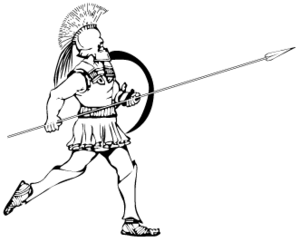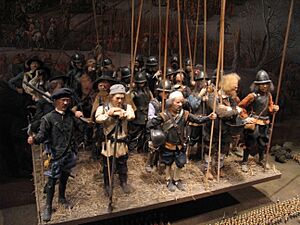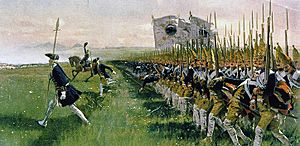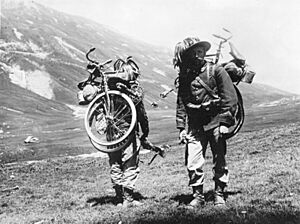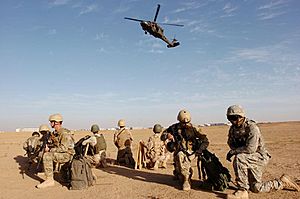History of infantry facts for kids
Infantry refers to soldiers who fight on foot. Even though the word "infantry" became common in the 15th century, it describes foot soldiers from all times in history. These soldiers used many different weapons before firearms were invented.
In ancient and medieval times, infantry was often grouped by their weapons and armor. There were heavy infantry and light infantry. Light infantry usually acted as scouts or skirmishers. They would screen, or protect, the more heavily armed heavy infantry. Heavy infantry often formed the main part of many armies.
When firearms became common, line infantry became very important. Their name came from how they fought in long lines. During this time, light infantry were often skilled marksmen. They still scouted and screened for the main army. This era also saw the start of naval infantry units, also known as marines.
Later, with new ways to travel like motor vehicles and aircraft, new types of infantry appeared. These included motorized infantry (who rode in vehicles) and airborne infantry (who parachuted from planes). Special units like mountain infantry were also created. Today, light infantry are general soldiers who play a key role in modern warfare.
The word "infantry" comes from the Latin word infantem. This meant a "foot soldier" who was often less experienced or lower in rank than cavalry. In military history, it is now a common term for foot troops from all historical periods.
Except for the Mongol Empire, infantry has always been the largest part of most armies. Infantry soldiers move on foot for tactical movements. But since the invention of trains and motor vehicles, they are often transported to the front lines. Airplanes are also used for strategic transport.
In ancient times, infantry often fought in loose groups. Commanders would shout orders to their troops. Over time, armies learned the benefits of uniforms, good equipment, and training. This led to organized formations that could perform planned moves during battle.
Since then, infantry organization has tried to balance different things. They want strong formations with lots of firepower that can resist attacks. But they also need lighter, faster units that can move quickly around the battlefield. Mobility, weapons, and protection are the three main factors that armies try to balance when developing infantry tactics.
Contents
Infantry in Ancient Times
Infantry was the main fighting force in the Classical period. Famous examples include the Immortals of the Persian Empire. The hoplites of ancient Greece and the legions of Imperial Rome were also powerful infantry. Besides these organized units, many ancient armies also used irregular troops. These were often mercenaries who wore less armor and fought in looser groups as skirmishers.
As the Roman Empire declined, the large, organized infantry units became less common. The resources needed to keep up such armies disappeared until the later Middle Ages.
Infantry in the Middle Ages
For most of the Middle Ages, warfare was dominated by cavalry, or soldiers on horseback. Knights, who were usually nobles, made up the cavalry. Infantry soldiers were often commoners. This slowed down new ideas for infantry tactics and weapons.
However, by the end of the Middle Ages, new weapons appeared. Pikes or halberds were used to counter the long lances of knights. More ranged weapons like bows were also used. These helped against the cavalry's speed and power. From 1350 onwards, knights often dismounted to fight on foot. They became super-heavy infantry themselves. This was a way to fight against massed archers who could shoot down their horses. This led to new tactics combining archers and dismounted knights.
Early Modern Infantry
Even though bows were still used, firearms became more popular. The development of the matchlock gun allowed firearms to replace the famous English Longbow. It was also easier to train musketeers (weeks) than longbowmen (years).
Gunpowder weapons like the lighter arquebus and heavier musket became very important. The Swiss Pikemen and German Landsknechte also had great success. These two types of soldiers dominated warfare in Western and Central Europe.
At the Battle of Cerignola, a Spanish force used 1,000 arquebusiers. They defeated a much larger French army, mostly Swiss pikemen and gendarmes. This battle showed how effective handheld gunpowder weapons could be. Their popularity grew steadily until they replaced most melee weapons.
At Cerignola, the Spanish used mixed groups of pikemen and musketeers called "Coronels." These later became the Tercio. The Tercio was a mixed formation of pikemen and musketeers. Over time, more musketeers were added, and swordsmen were removed. After the Spanish Tercios, other nations also combined firearms with very long pikes. These units were almost unbeatable against cavalry.
In the late 1500s and early 1600s, the Dutch leader Maurice of Nassau made changes. He made the Tercio smaller and gave it more firepower. He did this by reducing the number of ranks, making the formation thinner. The smaller Dutch Regiments had two battalions of 550 men each. They could fight together or separately. This way of organizing infantry became common in armies by the 1700s.
As firearms got better in the 1600s, the number of muskets compared to pikes increased. It went from about 1 musket for every 1 pike to 4 or even 6 muskets for every 1 pike. Infantry formations also became thinner. The Spanish Tercio was about 25 ranks deep. The Dutch Battalion was 10 ranks deep. The Swedish Brigade was reduced to six or even four ranks deep. The Swedish reforms under Gustavus Adolphus showed Europe how powerful firepower could be. By the 1700s, the standard infantry line was three ranks deep. This continued until World War I, becoming two ranks deep in the Napoleonic Era. Eventually, soldiers fought in skirmish lines by the end of the American Civil War.
Later, with the invention of the bayonet, pikemen were no longer needed. The bayonet was a knife fixed to the end of a musket. This meant one soldier could have both a firearm and a spear. This led to the first infantry units that look like those we know today.
By the early 1700s, line infantry became the main type of infantry in Europe. Line infantry used smooth-bore muskets with bayonets.
In the 1700s, light infantry also appeared. These were skirmishers who protected the main infantry. All major European powers developed special light infantry units. Light infantry, like German Jägers, used early rifles. These rifles took a long time to load (up to one minute). So, light infantry played a supporting role.
Modern Infantry
Before railroads in the 1800s, infantry armies walked or traveled by ship to battles. The Republic of Venice created the "Fanti da mar" in the 1400s. These were the first troops trained to fight from ships. The oldest existing Marine corps was started by Spain in the 1500s. Other European countries, including the United Kingdom, followed in the 1600s.
British Royal Navy warships carried many marines. These marines helped keep order on the ship and trained regularly. They were skilled with weapons and gunpowder. They would form landing parties when exploring new lands. Marines also defended the ship if enemies boarded it.
In the mid-1800s, during and after the American Civil War, the United States used infantry a lot. They fought in battles and helped open the western frontier. The Buffalo Soldiers were an example of infantry and cavalry used after that war.
In the 1890s, some countries, like Italy with their Bersaglieri, used bicycle infantry. But the biggest change in how infantry moved came in the 1920s. This was with the use of motor vehicles, leading to motorized infantry.
During the 1800s, new firearms made close formations outdated. Rifled guns, breech-loading weapons, and automated guns like the Gatling gun changed warfare. These weapons fired further and more accurately. By the late 1800s, fighting in formations was less common. The difference between skirmishers and heavy infantry disappeared. In World War I, new deadly weapons like artillery and machine guns led to trench warfare.
World War II showed how important it was to protect soldiers while they moved. This led to mechanized infantry, who use armored vehicles for transport. World War II also saw the first widespread use of paratroopers. These soldiers parachuted from airplanes into combat. They played key roles in several battles.
Infantry After 1945
In the Vietnam War, infantry often used technology to get to battle. The United States Army used helicopters to quickly move infantry between locations. These units are now called airmobile infantry. Delivering infantry by helicopter is known as an air assault.
Most infantry today are either motorized or mechanized. They are supported by armored vehicles, artillery, and aircraft. But along with light infantry, who do not use armored vehicles, they are still essential. Infantry is the only military force that can take and hold certain types of land, like cities.
The purpose of infantry uniforms has also changed. They used to just identify allies and rank. Now, uniforms are practical combat gear. They focus on camouflage and protecting the soldier.
See also
- Infantry tactics


